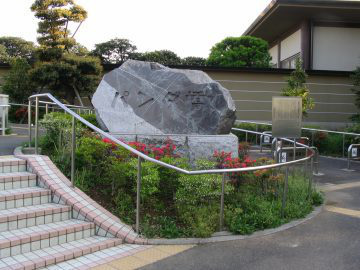
01. The Remains of Sites along the Ueno Station
5, Ueno park
Within the grounds of Ueno Tokyo Metropolitan Park are the clustered ruins of Ueno Shinobugaoka. Containing archeological sites spanning from the Jōmon Period (ca. 10,000-ca.300 B.C.) up through the early modern period (17th-mid 19th centuries), this area was once part of the Kan-eiji Temple complex. The actual ruins are located along the southeast edge of the Ueno plateau. From 1634 this was part of a branch temple of Kan-eiji Josho-in however in 1678 it became Ryoun-in Temple. From the middle of the 18th century, Ryoun-in came to serve as the burial site for the three powerful houses of the Tokugawa bakufu; the Tayasu, Hitotsubashi, and Shimizu families.
During an excavation in 1998 it was discovered that the northeast side of this site contained terrace and an underground chamber etc. in 17th century. The remains are thought to be associated with Josho-in. In 19th century the north side was leveled in order to make a graveyard. Relics recovered from the underground chamber include Chinese porcelain, copper lamps, and unglazed hajishitsu plates embossed with pine-bamboo and crane-turtle motifs.
Remains from early Jomon, latest Yayoi (3th) later Kofun (6th, 7th), Nara (710-794), and Heian (794-1185) periods have been discovered, including the carbonized roof from a Kofun period dwelling that burned down. From the remains of the house fire, unglazed hajiki cups and kinkan (gold and silver embossed bronze earrings) have been recovered.
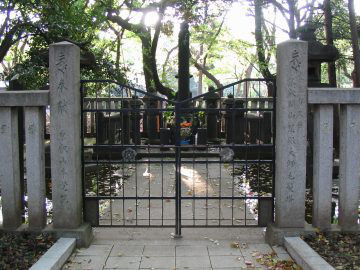
02. Hair Pagoda for Priest Tenkai
Metropolitan Historic Site
1, Ueno park
Tenkai (1536-1643) was a high priest of the Tendai Sect at the beginning of the Edo Period, He was also known as Jigen Daishi. He took orders at age 11. At 14 he climbed Mt. Hiei and began formal training in the precepts of Tendai Buddhism. With the founding of the Tokugawa bakufu government at Edo (Currently Tokyo), Tenkai received the favor of Tokugawa Ieyasu. Upon the death of Ieyasu, he was permitted to take a saintly name in order to deify the Tokugawa founding shogun. At roughly the same time the basic designs of the shrine at Nikko were being laid out and Tenkai served as an advisor in its construction. Following this, he also benefited from the attention of both Shōguns Hidetada and lemitsu and was installed at the newly built Kan-eiji Temple in 1625 for the spiritual protection of Edo Castle.
In 1643, at the age of 108 he passed away at Hongaku-in Temple, a branch temple of Kan-eiji, and as ordered, was buried on Mt. Nikko. A pagoda to commemorate him was built at this site, and later, priest of Hongaku-in built a second pagoda in order to house a lock of his hair. Thus, this pagoda has come to be called the Hair Pagoda.
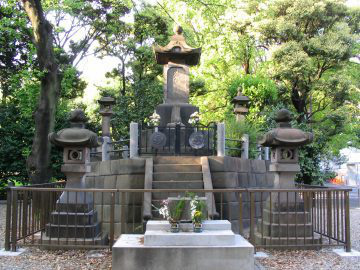
03. Tomb Site of Shogi-tai Solders
Taito City Tangible Cultural Properties
1, Ueno park
Shogi-tai was an army of the Tokugawa shogunate, which was organized in 1868 to fight against the Emperor at the end of the Edo Period. They fought around here on fifteen of May in the same year. In those days Ueno-no yama (Ueno hill) was in the precincts of Kan-eiji Temple (Tokugawa shogunate's family temple), where there were many temples and pagodas. But the battle was so intense that almost all of them were destroyed. The Shogi-tai was defeated by the evening of the day. The fight is called Ueno war or fight of Shogi-tai.
These two tombstones were erected for the Shogi-tai soldiers killed here. The small tombstone in the back by a survivor, a soldier called Ogawa Okisato and several of his comrades.
These tombstones were registered as important cultural assets in 1990 in the Book of Cultural Assets of Taito City.
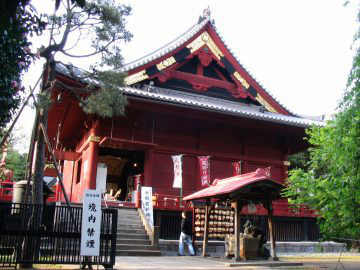
04. Kiyomizu Kannon-do
Important Cultural Properties
1-29, Ueno park
Kiyomizu Kannon-do was established in 1631 by Tenkai Sojo (high Buddhist priest), Who was the founder of the Kan-eiji Temple, following the pattern of the Kiyomizu-dera Temple in Kyoto. At first, it was located on the far side of Suribachiyama hill, but in 1694, it was relocated to its present place.
As the building became too old, its restoration and rebuilding started in 1990 and was completed in May of 1996. During reconstruction various factors were revealed. Among them the finding of a wooden plate which tells that this building was built in 1694 overturned the previous established view that it had been built in 1696.
The principle image of this temple is a seated figure of Senju-Kannon and was moved from Kiyomizu-dera in Kyoto. As it is a secret image, it usually is housed in a miniature shrine, but it is shown to the public on the first horse day in February and attracts many visitors.
Kosodate Kannon, the child-growing Goddess of Mercy, which is the subordinate image, is the idol of those who hope for child-bearing and sound child-growing, if they have the fortune of giving birth to children, they are to offer dolls as the substitute for their real children. The memorial service for dolls held on September 25 every year in a well-known event.

05. Shushiki Cherry Tree
1, Ueno park
Ueno was very famous as a place of cherry blossom from the beginning of the Edo Period. There were many species of cherry trees and some trees had even their own names; a typical one of them is the Shushiki Cherry Tree.
In the Genroku Period, a daughter named Oaki of a sweet shop in Koamicho, Nihonbashi wrote a Haiku poem, "Cherry blossom near a well are in danger by drunken fellows." This expresses a scene of crowded cherry blossom viewers near a well. She was only 13 years old at that time but had a pen name of Shushiki. Therefore, this cherry tree near the well was called "The Shushiki Cherry Tree."
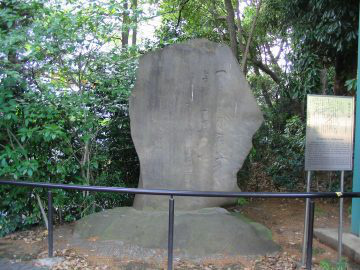
06. Monument to Shokusanjin
4, Ueno park
Shokusanjin is well known by the name of Ota Nanpo. He was skilled in humorous competition and the writing of comic tanka poems and had an extensive knowledge of Chinese and Japanese literature. He was said to be typical of Edo literary men, and in the field of comic tanka poems along with Karagoromo Kisshu and Akera Kanko he was referred to as one of the "Three Great Masters". He died in 1823.
From the Edo Period (1600-1868) Ueno was famous for its cherry blossoms and in 1938 a monument to Shokusanjin was erected at the ruins of Kuro-mon Gate at Kan-eiji Temple, engraved with a poem by Shokusanjin describing the Ueno cherry blossoms and Kuro-mon Gate.
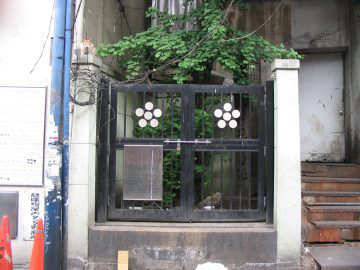
07. The Ruins of the Former Gojo-Tenjin Shrine
4-10, Ueno park
This is the place where the Shrine of Gojo-Tenjin, well known as the god of medicine, was situated from 1697 to around 1923.
Gojo-Tenjin shrine was previously located at Ueno-yama (present Ueno Park), at the latest, in the middle of 15th century, being one of many old 'Shinto' shrines in Taito City.
Soon after this shrine was moved from Ueno-yama in 1697, a town grew up surrounding this area to be called Gojo-Tenjin Monzen (Gojo-Tenjin shrine town) forming a lively quarter in Ueno-Hirokoji. The shrine was again moved to the nearby neighborhood due partially to railway construction by Japanese National Railways, and then to the western part of Ueno Park in March 1928, where the shrine buildings were constructed as they are now.

08. Benten-do
2, Ueno park
This Benten-do was constructed by Mizunoya Katsutaka in the early 17th century. He was a lord of the present Shimodate City, Ibaraki Prefecture area. He made a manmade island and made it a subsidiary of the Benten at the Hogon-ji Temple on Chikubu Island in Lake Biwa (Shiga Prefecture).
At the time, it seems that crossings to the island were made by boat, but a stone bridge was erected in the late 17th century and since then it has been visited by many people. The original hall and important Cultural Assets were destroyed by a US air raid in 1945. It was rebuilt in 1958.
The "Kin ryu (golden dragon)" on the ceiling of the hall is a work by the painter Kodama Kibo and the dragon on the ceiling of the water basin was painted by the famous early 19th century artist Tani Buncho.

09. Bell of Time (Toki no Kane)
4, Ueno park
"Sounding through cloud of flowers - is it the bell in Ueno or Asakusa? "
What was alluded to in this well-known Haiku (seventeen-syllable Japanese verse) by Matsuo Basho is this bell. The “bells of time" played the part of informing Edo citizens of the time of the day. This bell on Ueno hill was one such bell.
The first bell was cast in 1666. The present bell was recast at the Kannon-ji Temple (present Tenno-ji Temple) in Yanaka in 1787.
Thanks to the efforts of the volunteers protecting the belfry, the bell issues its time-honored sound three times a day - at 6 a.m., 6 p.m. and at noon.
"The bells of time" has been selected as one of the " one hundred selections of Japanese sounds and scenes which will remain forever," settled by Agency of Environment since June 1996.
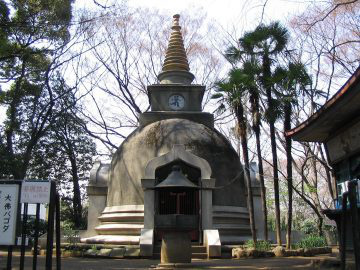
10. Ueno Great Buddha and Pagoda
4, Ueno park
During the Edo Period within the precincts of Kan-eiji Temple, there was a great Buddha statue on top of hill. This site is known as "Daibutsu yama"(Great Buddha hill).
In 1631, the first great Buddha was created by a feudal lord Hori Naoyori. Lord Hori governed the area around Murakami in Niigata Prefecture. It was a seated Buddha of 2.8 meters in height but was destroyed by an earthquake in 1647.
The second Buddha was created by the monk Jyoun who collected (donations) money from Edo citizens. It was also a seated Buddha 3.6 meters tall.
The face of the second Buddha images fell off during the Great Kanto Earthquake in 1923, and later the body and pedestal were delivered to the government under the Metal Acquisition Law, which ordered the delivery of metallic goods owned by citizens to the government, to produce weapons during the World War II. Only the face remains at Kan-eiji Temple. In 1967 a wall was built on top of the hill and the Buddha head was enshrined on the wall in a relief style setting. Then in 1972 the Ueno Tourist Association built the current pagoda, including three Buddhist images of Yakushi Nyorai (Physician of souls), Gekko Bosatsu and Nikko Bosatsu.
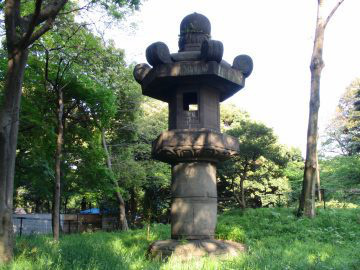
11. A Huge Stone Lantern (Monster Lantern)
4, Ueno park
This huge garden lantern made of stone was offered as a gift from Sakuma Daizennosuke Katsuyuki to the Toshogu Shrine in 1631. It is said to be one of the three great stone lanterns in Japan, together with those in Nanzen-ji Temple of Kyoto and in Atsuta Jingu Shrine.
The dimensions of the lantern are impressive, its height being 6 meters and the perimeter of the capping stone 3.6 meters.
Because of its great size, people commonly call it "Monster Lantern."
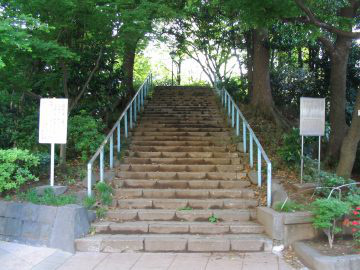
12. Old Tomb on Mt. Suribachi
5, Ueno park
This mountain was called Mt. Suribachi (it means earthenware mortar) because its shape looks like the inverted earthenware mortar. From here, the earthenware of the Yayoi style as well as broken pieces of haniwa or clay images were found, so that it is considered the relic of an ancient burial mound square at the head and rounded at the foot, constructed about 1,500 years ago.
The present length is 70 meters, and the diameter of the circle at the back is 43 meters. As for the square part in front, the maximum width is 23 meters. The difference in height with the path in the round part at the back is 5 meters. On the top of the mound, there was a shrine dedicated to the Gojo Tenjin Shrine, and the Kiyomizu Kannondo (temple dedicated to a Kannon) was there, too. Now, it's used as a resting place.

13. Bronze Statue of Prince Komatsu no Miya Akihito
8, Ueno park
Akihito was the eighth prince of Fushimi no miya Kuniie. He joined the Toba/Fushimi war in January 1868 as the commander-in-chief and also took part in the Boshin war.
In 1877 he established an organization called "Hakuai-sha" to help the wounded of the Seinan war and headed the association. When it was renamed "Japan Red Cross Society," he assumed office as its president and contributed to the development of the society. He passed away at the age of 58 on the 18th January 1903.
This bronze statue was erected in February of 1912. The sculptor was Okuma Ujihiro, a Bunten art exhibition judge. The reason why the statue was erected here is presumed to be that Rinnoji no miya, Akihito's elder brother was the last Monseki of Kan-eiji Temple.
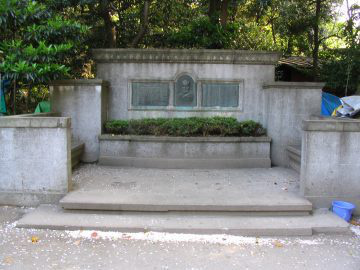
14. Memorial Tree Planted by General Grant
8, Ueno park
A General Ulysses Simpson Grant had served in the American Civil War as a colonel in the volunteer corps of the northern forces. Distinguishing himself on the battlefield, he later became Supreme Commander and led the northern forces to victory. In 1869 he was made president of the United States of America and remained in office for two terms until 1877.
From 1877 to 1880 General Grant toured the world with his family. He came to Japan and on August 25th, 1879 at the large reception given for him here in Ueno Park he planted an oak and his wife planted a yulan in commemoration. The trees they planted have now grown large.
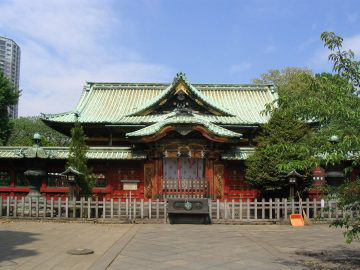
15. Ueno Toshogu Shrine
Important Cultural Properties
Ueno Toshogu Shrine, 9, Ueno park
Todo Takatora built a shrine dedicated to Tokugawa Ieyasu within the compounds of his residence on present-day Ueno hill in 1627. That shrine is said to be the origin of Ueno Toshogu.
In 1646, the court presented Ieyasu with the princely name of Toshogu. Subsequently, the shrine dedicated to Ieyasu came to be called Toshogu. The present building was rebuilt at the time of Iemitsu, the third Tokugawa shogunate, with the work completed in l651. The shrine building, which is of the so-called Gongen structure, has been designated as an important cultural asset of the nation.
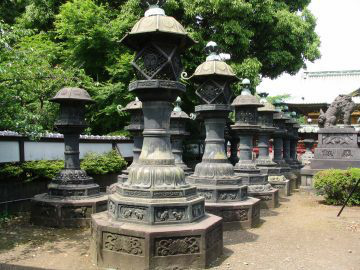
16. Copper Lanterns
Important Cultural Properties
Ueno Toshogu Shrine, 9, Ueno park
There are 48 copper lanterns at Toshogu shaden Karamonmae (in front of Karamon gate of Toshogu Shrine main building) and Sando (the approach to the shrine). The lanterns are not used for illumination purposes but are used for purification and sacred fires required when performing religious ceremonies. These copper lanterns were the offerings of the Daimyo's (feudal lords) from all over Japan to Toshogu Shrine. The names of the donors are written on the supports of the lanterns. These lanterns, together with Toshogu Shrine's main building, are designated as National Treasures of Japan.
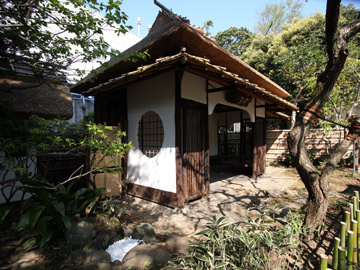
17. Kankan-tei Tea-ceremony House
9, Ueno park
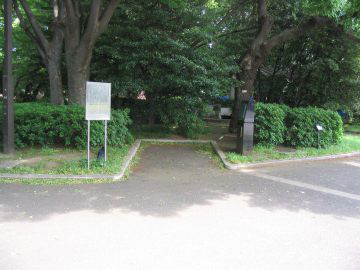
18. The Site of Kan-eiji Temple Konponchu-do
8, Ueno park
In the Edo Period the area of the present-day Ueno Park was the grounds of Kan-eiji Temple and it was full of temple buildings and monasteries. The area where the fountain and pond are now located was called "Take-no-Utena"(Pedestal of Bamboo). There were cloisters and if one passed through Chokugaku-mon Gate one would see Konpon Chudo Hall.
Konpon Chudo was the central building of Kan-eiji Temple, and inside it Yakushi, the Buddha of Healing, was enshrined as the principal image. In front of Konpon Chudo on both sides bamboo from Enryaku-ji Temple in Omi Province (present Shiga Prefecture) was planted; hence the name Take-no-Utena.
On 15th May 1868 this area was the site of a major clash between feudal and imperial forces in the civil war that led to the Meiji Restoration, and most of the buildings and cloisters of Kan-eiji Temple were burnt down.

19. Bronze Statue of Noguchi Hideyo
8, Ueno park
Noguchi Hideyo was born in 1876 in Fukushima Prefecture. Going to the United States of America in 1900, he began research on the syphilis spirochete at the Rockefeller Medical Research Institute in 1904. From 1918 he continued his research in Central and South America, as well as Africa where he hoped to study Yellow Fever. However, before long, he himself contracted the disease and in 1928, at the age of 53, he passed away in what is how the country of Ghana.
The approximately 4.5 meters statue of Noguchi was made by Professor Yoshida Saburo of the Tama Art University, Heating a test tube in the midst of experimentation, the Latin words, "PRO BONO HUMANIGENERIS" ( "For the Good of Humankind" ) , are inscribed on the stone base.
Plans for erecting the statue began in 1947 when Tamao Fumio of Fukushima Prefecture initiated fundraising. The Japan Medical Association's Kitasato Institute continued with the Noguchi Hideyo Memorial Society after Mr. Tamao succumbed to illness. The fund drive was completed in March 1951.

















